
|
 When the Drummers Were Women : A Spiritual History of Rhythm by Layne Redmond List Price: $18.00 Our Price: $14.40 You Save: $3.60 (20%) Order Drummers Today! |

A Child Prodigy grows up, An Interview with
Reda Darwish
by Lynette Harris
When
I was talking to my brother who is in Sydney recently, he said that he
had brought me a small American trap drum set when I was seven years old.
Next, he brought me the bongos. I was interested in a variety of music
even at that time. When I turned eight I appeared on an Egyptian television
show for kids, which was called "Ganit
el Atffal" (Heaven
for Children). Mama Samiha,
was the star and Mistress of Ceremonies of the show. In order to be on
the show, kids had to have an interview, then the staff did an audition
of the child playing with the other musicians. I played and made it onto
the music staff of the show. I was happy! Every Friday the show scheduled
to air a musical presentation for children. I made a little money too!
I played the trap drum set and the bongos on that show. I filled in on
the drumset when the regular drummer was gone as well as playing my bongos.
Also, my brother used to take me along with him. Though he's an engineer
and artist, he plays the tambourine. He often took me along to shows when
he was going to be performing. I performed with him, too, sometimes. He
gave me a few Egyptian pounds for my pocket. I was really happy to be
earning that kind of money at that age!
Eventually, I quit the television show and played at my school for the pledge to the Egyptian flag. At that time,
the music teacher asked me to play for her dance class. This was the third grade class at Atef Baraket Primary School. All
of the girls are required to take this class. I joined and played for them. That was very fun. When I was in the
fifth or sixth grade, I returned to the television building because they were having a big group under the maestro
from the army, Abdel Aziz Armer Ghazal. Again I was required to audition before I was accepted into the show. I somehow convinced
the violin and accordion players to play the melody while I played the bongos. It was scary for a young kid because
the people were looking at me. We played a piece from Oum Kalthoum. I was anxious for this one because there was a major producer present who was
a friend of my eldest brother.
I am the youngest of five children, three brothers and one sister. My eldest brother was Ahmed Darwish; he was a lyricist. He
was a friend of the late Abdul Wahab Mohammed, a songwriter, or lyricist for Oum Kalthoum. In Egypt they are called "songwriters."
The songwriter writes the words and the composer writes the melody. It is confusing but Abdul Wahab Mohammed is
a different person than Mohammed Abdel Wahab. My brother also had an additional job with an oil company, and he did songwriting part
time. My brother died about 10 year ago.
My next brother, Farouk,
is a draft engineer in Australia and he also plays the tambourine. My whole family was into music and art. They
were fearful of my being away from school because of the music. One can play the music and also stay in school.
They were afraid because I started playing in the nightclub scene very young, twelve years old. The bad reputation
of the clubs included drugs, and they were scared that I might become involved in drugs and worried for my reputation
because I was playing for dancers. I had to wake up early in the morning, but I was making good money. First I
was playing for a few dancers every night. There were two or three dancers, each in different nightclubs. Among
them were Sohair Ahmed,
Zezit, and Mirvet Bader, who is well known
now. Then they were considered third class. I will tell you all the dancers. But, remember, this was at a young
age for me, and I don't remember the exact times or order. More dancers I played with included: Amar Gamal, Hanan, Rebab. Rebab
was married to a famous accordian player at that time called Farouk
Salamah. I played for Mona
Abrahim. (This was a good group, a move up for me.) I played
for weddings also. I went up another serious step when I was played for Fifi
Abdu. I stayed with her and her good group, for quite a while.
Then I quit Fifi and joined Nelli Fuoad's group.
I remember one incident that I'll never forget! In a nightclub in Giza, the "Lona
Bark", I was working for Fifi Abdu, but I wanted to
go to a different band, to quit playing for Fifi and go to Nelli's group. I was very important in Fifi's group
and she found out I was going to leave. After we finished the show, I was on my way to tell her that I was going
to quit.On my way, one of Fifi's assistants that carries the instruments confiscated my bongos. Fifi wouldn't give
them back to me! Usually we would go to the coffee shop in the morning to be paid. I almost cried. These were the
bongos that my brother brought me from Lond
on. I was a kid and they made fun of me, mimicking me and taunting me. In the morning, about 5:30 a.m., Fifi came
in her car and tried to convince me to stay with her. I didn't stay, but none the less, Fifi and I remained good
friends. Nelli paid me more money and I recorded with her husband, who was a keyboard player.

Reda says this is the wrong album, although this is Nelli Fouad. Does anyone
out there have the first "Cairo by Night" album?
My other brother and sister are not involved in music.
I recorded "Cairo by Night" with Nelli. It was my first professional recording completed while I was thirteen or fourteen
years old. I accompanied the famous accordion player, Hassan Abu
Saoud. He is the king of the accordion in the Middle East. He
calls himself that too! This album was recorded in Studio #34 in the television building. The sound engineer in
Studio #34 was the main guy who worked with Oum Kalthoum.
I played with Catkot El Amir,
nicknamed "the Cat". Later, I played for the dancer Aza
Sharif. She used to be married to Catkot El Amir. After that,
Nahid Sabry.
Now, we are talking about first class dancers. For example:
1 class, Sohair Zaki, Nagwa Fuoad, Nahid Sabry, Mona Said
2nd class, Aza Sharif, Nelli Fuaod, Fifi Abdu.
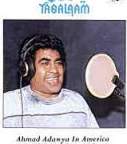 I also performed with Ahmed Adaweya. He was the singer
on the "Ya Salaam" tapes.
I also performed with Ahmed Adaweya. He was the singer
on the "Ya Salaam" tapes.
Let's go back again to Nahid Sabry. She, I think, has a unique style, up to now, that no one can do, in my opinion.
I haven't seen any dancer dance that fast and still can do technique! When she runs on the stage, she's like a
horse, never giving up for almost one hour, like fire from A to Z!
Then, I went to Sahar Hamdi.
The reason I went from one to the other was that I wanted to explore, and I also went with whoever was willing
to pay the most. I needed to expand at that time. I knew Sahar Hamdi from the time when she used to be a customer
watching Fifi Abdu. She came just to watch. She became interested in the dance and started her own group. Boom!
She was big right away! Then I came to play for her. She became a very good dancer.
I went to play for Mona
Said. Mona Said was considered right up there with Nagwa Fouad and Soheir Zaki, except she was mostly performing
in London, not Cairo. Mona Said paid the highest pay I ever received from a dancer. In Egypt, the dancers hire
the musicians; they inquire about who plays well and they search for that musician. Since I was experienced, and
known from here to there, I was recommended to her. Mona Said hired the most sophitiscated musicians at that time.
For example, Samir Srour
on saxophone, Saad Mohammed Hassan
played violin, Omar Farahat
also on violin, and the keyboard player, Mohsen Adley. This is top of the line!
When I quit the nightclub scene and weddings, I began to play with Hani
Mehanna 's Orchestra and worked big concert gigs and with them,
I recorded for big stars. I became a studio musician with better hours and would go every day into the studio.
There weren't many recording studios at that time. Musicians went to the television building to Studio #34, #41,
and #46. Studio #46
and Zakaraya,
the sound engineer, did the entire recording for Mohammed Abdul
Wahab. Studio #46 was it, the pinnacle! I didn't work with any
dancers anymore.
My family only requested that I was good in school. I passed and have a degree in Egyptian law. I was studying
my academics and my music altogether. During my second year, I failed my law school exams. I was going to my exams
when my father died. I had studied well, and my family insisted I go to my exams. I tried, but I could not think.
I failed in all five subjects. I repeated the work and the exams over the following year. I graduated from law
school at Cairo University in May 1980.
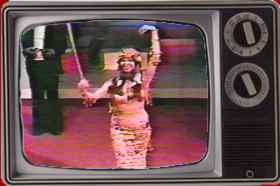
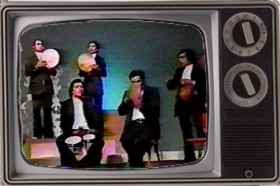
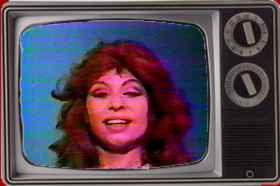
On the VIDEO with Mona Said:
Famous nai player was with Oum Kalthoum, Jalal Hussin. He played the song Ya Maseherni with her.
Saxophone, Samir Srour
There was the most classical violin player, Abduou Dagher!
Our keyboard player Mohsen Adley,
was the main man for Orchestra EL Ferka El Mesaya (Maestro Ahmed
Fouad Hassan). (I also played with this orchestra for about 2
month before I went to play with Hani Mehanna Orchestra.)
Mona Said came from London for this video and paid a lot for this group. The other mizmar player played for Abdul Halim; his name was Ahmed Kawatim. (Kawatim means
rings.)
Here is a story of that video: Nobody in my neighborhood knew for whom I was playing. I didn't tell people I was
playing for dancers. On a Thursday night on television a lot of people were watching when this video aired. Here
is Mona Said, and there I was. The next day everyone told me, "There you were with Mona Said!"
Mona was excellent.
Every dancer I worked with had a different character. Fifi was fun. She does a great show, unless she doesn't want
to dance. If you see her in a good mood, she does a great show. Mona Said was always like a princess; she's a fanana,
an artist. We call the dancers, "fanana," not a dancer. One who absorbs the music, not just a dancer!
I loved being with every one of them!
I have lost count of all the people I played with and for in the studio. I also played deff, tar, conga, whatever
was needed for the recording.
I played for lots of singers like Fayza Ahmed, Nagat Ilsaghira,
Samira Said from Morocco. Not just anybody is allowed to play
for these people.
After that, I played along with Meharem Fuoad, Hani Shakir, Medhat
Saleh, Mohammed Tharwat, and Mohammed
El Isabi, who sang with the
Reda Dance Troupe, Yasmeen
el Kayam (these are all singers) and Ali El Hagar. All of these performers,
I played for in recordings and concerts: Omar Fathi, Mayeda El
Hinaoui from Syria, Suad
Mohammed of Lebanon, and Afef
Radi.
In one event, I performed for Beligh Hamdi, a great composer for Oum Kalthoum and Abdel Halim Hafez. I was in Kuwait for a national
festival on television. He sang one of his songs that he wrote for Oum Kalthoum. Another composer/singer there
was Sayed Makoui.
He is a blind man, and did "Ya Maseherni" for Oum Kalthoum. Hani
Shaiker and
Fayza Ahmed, were singers accompanied by our orchestra, Hani
Mehanna. I did this after law school and after I was in the Egyptian army for one year. The event of which I was
speaking, lasted one week in Kuwait. I did all of this before I came to the US. I started at such a young age.
Another event, was performance with our orchestra, at a private party with Nagat
el Saghira. The special dancer for that event was Samia Gamal. She came out of
retirement to do this party. Her own drummer, Mahmoud Hamouda, recommended me. He is one of the greatest drummers. He plays for Reda's troupe
also and Hani Mehanna. I admired Samia Gamal as an artist, a true artist. It was a total pleasure to work for her.
We called her Fanana Samia. I received more money for Samia Gamal than from Nagat el Saghira.
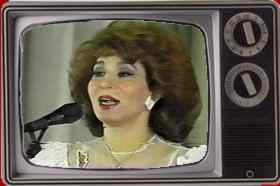
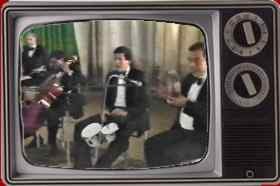
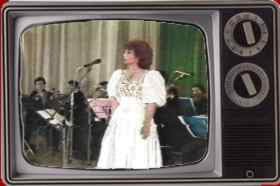
On this second video...
...I was with the singer, Fayza Ahmed, and with the Hani Mehanna Orchestra. Fayza was a wife of Mohammed
Sultan, a composer. He is recording the albums for Leyla Haddad now. Those musicians, most of them, were really famous; they played for Oum Kalthoum.
I was the only drummer with her. Oh! She also had a trap drum set. We were the main group.
For so many years, I worked with great composers for all these people: Balegh
Hamdy, Riyad Simbati, Said Mekoui, Ahmed Sadi, and Mohammed El Moughi. The composers
have to come to the recording studio with the artists, so I worked with them all.
In France I went with a female singer and actress from the "old time TV days" named Shadia for a wedding for a Saudi Arabian
princess. We stayed for three weeks. A special song was composed for this princess by Helmy Baker. I returned to Cairo, after
that, the United States. I came to the U.S. when I was twenty-six and that was fifteen years ago. I did not intend
to stay here at all. I made good money all of my early career. I did parties in New York, Los Angeles, and in Florida.
Muharem Fuoad,
asked me to join them in Florida for a party, a wedding for Shiek
Mohammed El Fasi. We were suppose to stay only one week, but
we stayed one month, along with Sohair Zaki and her group. The Sheik paid for everything. We did one other concert after the wedding.
We played two events in our one-month stay. It was fun. This was my first month in America. Next, I went to Los
Angeles and played in a nightclub, the Sahara beside the Hollywood Theatre (one block away). I worked in Jordan with Latifa Tunasia from Tunisia,
five years ago, at the "Maharajan Gharish", (the Festival Gharish). It happens every year in Jordan.
At that time, I was waiting to go to London for another gig, and there was nothing here for me. I knew that there
was big money waiting for me in London. It didn't happen. I came to San Francisco and played at the Bagdad Cabaret. It was supposedly
just to fill up the time until I was to go to London. I found out that the work permit in London was going to be
very difficult to get. I had an "H1 Visa" here, which is a work permit with which one may go back and
forth. I used to make good money, and I know I still have the ability to make good money in Egypt. I like it here,
even though I make less money! I now drum with the oud players,
Raad Zawaidlh and Elliot
Bales, at Café Amira in San
Francisco. I also usually play at Cleopatra's on Friday with Nazir Latouf and at Salamat
Sundays with the
Arabian Knights. I've never revealed muc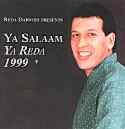 h about my background. Only a few people have known
about me. I have my videos. I have played for people who will only play in concerts, the top! Whenever I return
to the Middle East, I am always blessed to get work.
h about my background. Only a few people have known
about me. I have my videos. I have played for people who will only play in concerts, the top! Whenever I return
to the Middle East, I am always blessed to get work.
On Reda's Flower and Valley of the Kings, I included my own original composions. These were produced by Horacio Cuefentices. Ya Sallem Ya Reda, and Walk with the Moon. Now these last two are vavailable on one CD.
Photo #1
This photo was taken three years
ago in rehearsal for Hani Mehanna's comeback show. We played his music
for Abdul Halim.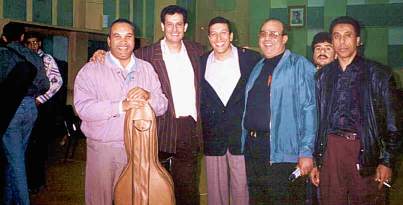 This
was a very big show, with sixty people in the orchestra. The singers were
Zakra from Morocco,
Medhat Salah,
and another singer. Hani Mehannin is the one of the main keyboard players
in Egypt; he has his own group. Violin player Tamir (in back with glasses) is a famous
arranger in Egypt. The cello player is Asherf Sharara,
the son of Atya Sharara,
from an old Cairo family, and another well-known composer. His brother
Hassan Shahara also participated as a soloist in
this show. The next man is Hani Mehanna. When he started, he had his own
group of ten musicians, the Hani Mehanna show, performing for Moherhem Fouad, Hani Shaker.
These are the main singers in Egypt. Hani Mehanna composed "Mashaal". I recorded this with him. He composed
"Nasa" which I recorded with him also.
This
was a very big show, with sixty people in the orchestra. The singers were
Zakra from Morocco,
Medhat Salah,
and another singer. Hani Mehannin is the one of the main keyboard players
in Egypt; he has his own group. Violin player Tamir (in back with glasses) is a famous
arranger in Egypt. The cello player is Asherf Sharara,
the son of Atya Sharara,
from an old Cairo family, and another well-known composer. His brother
Hassan Shahara also participated as a soloist in
this show. The next man is Hani Mehanna. When he started, he had his own
group of ten musicians, the Hani Mehanna show, performing for Moherhem Fouad, Hani Shaker.
These are the main singers in Egypt. Hani Mehanna composed "Mashaal". I recorded this with him. He composed
"Nasa" which I recorded with him also.
There are so many more names, especially the people from the Gulf and
other Arab countires with whom I worked, that I can't name them here.
Another story, another time...
Now I plan to keep inspired, and to make my music. (Whatever I can do
with a small budget.) I know how much a big group costs. I'll never be
satisfied with sound less than I had with the big groups. My satisfaction
will come just to keep playing music. I have two sides of me: One when
I play with the big groups, and another when I play with two or three
musicians. My style is different with the two different sizes of groups.
My New CD is called "Halawah", meaning, pretty and nice girl,
or a dessert, "halvah", which is sweet sesame. Halawah was recorded
here, in San Francisco. The musicians included Samir Srour on sax. It
has two original songs and vocals on it. I hope everyone will like it!
It is mostly single songs on a fifty-minute compact disk album. It has
traditional songs from Upper Egypt and modern pieces too. It's good for
both listening and dancing. I believe it's a fine quality CD. I hope every
dancer likes it. It's available now!





About
Us, Ad
Guide, Archives, Bazaar, Calendar, Columns, Comics, Contents, Ed
Guide, Letters






